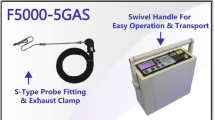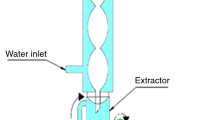Abstract
The present works focus on the preparation of a novel bio-diesel from Methyl esters fish oil and assessment in a compression ignition engine. The process is optimized with different oil-methanol ratio and catalyst concentration to obtain a maximum yield of 99%. With that purpose, B20, B30, and B40 (by volume) of biodiesel and isobutanol was added to diesel to make different blends, and its properties were estimated based on ASTM standard and compared with diesel oil. Based on the assessment on the Kirloskar TV1 model computerized direct injection compression ignition engine is has been observed that BTE increases by 12% for B20 fuel on par with diesel fuel. In contrast, HC and NOx have been decreased for lower blends of biodiesel as observed from the trade of plot. The results of different fuel blend operation have clearly indicated that there is an abundant possibility to pursue an optimization study where in the different input parameters can be set suitably to gain the utmost profit from biodiesel- diesel additive combination. Taguchi proposed an experimental design which involves the use of orthogonal array to organize the levels and the parameters influencing the processes. Besides, phase-based tagging Artificial neural network (ANN) is used to predict the best input mix, which resulted in the best performance characteristics. This multi-objective optimization technique shows that blend B20 has an optimal MPCI value of 0.68, which is the best blend to get higher performance and better emission characteristics.



























Similar content being viewed by others
Abbreviations
- deg CA:
-
degree Crank angle
- DI:
-
Direct injection
- HRR:
-
Heat release rate (J/ deg CA)
- ASTM:
-
American Society for Testing Materials
- CO:
-
Carbon monoxide
- NOx:
-
Oxides of nitrogen
- HC:
-
Hydrocarbon
- EGR:
-
Exhaust gas recirculation
- CI:
-
Compression ignition
- BTE:
-
Brake thermal efficiency
- EGT:
-
Exhaust gas temperature
- CC:
-
Combustion chamber
- NA:
-
Naturally aspirated
- A-F:
-
Air-fuel ratio
- ANN:
-
Artificial neural networks
- MAPE:
-
Mean Absolute Percentage Error
- MSE:
-
Mean Squared Error
- MIMO:
-
Multiple-input Multiple-Output
- RMSE:
-
Root mean Squared error
References
Agarwal AK, Bijwe J, Das LM (2003) Wear assessment in a biodiesel fueled compression ignition engine. J Eng Gas Turbines Power 125(3):820–826
Sastry GRK, Deb M, Panda JK (2015) Effect of fuel injection pressure, isobutanol and ethanol addition on performance of diesel-biodiesel fuelled DI diesel engine. Energy Procedia 66:81–84
Dwivedi G, Sharma MP (2015) Investigation and improvement in cold flow properties of Pongamia biodiesel. Waste Biomass Valoriz 6(1):73–79
Panda JK, Sastry GRK, Rai RN (2017) A Taguchi-fuzzy-based multi-objective optimization of a direct injection diesel engine fueled with different blends of Leucas zeylanica methyl ester and 2-ethylhexyl nitrate diesel additive with diesel. J Energy Resour Technol 139(4):042209
Singh M, Sandhu SS (2020) Performance, emission and combustion characteristics of multi-cylinder CRDI engine fueled with argemone biodiesel/diesel blends. Fuel 265:117024
Nguyen T, Pham M, Le Anh T (2020) Spray, combustion, performance and emission characteristics of a common rail diesel engine fueled by fish-oil biodiesel blends. Fuel 269:117108
Jagtap SP, Pawar AN, Lahane S (2020) Improving the usability of biodiesel blend in low heat rejection diesel engine through combustion, performance and emission analysis. Renew Energy
Gad MS, Jayaraj S (2020) A comparative study on the effect of nano-additives on the performance and emissions of a diesel engine run on Jatropha biodiesel. Fuel 267:117168
Sharma A, Singh Y, Singh NK, Singla A, Ong HC, Chen WH (2020) Effective utilization of tobacco (Nicotiana Tabaccum) for biodiesel production and its application on diesel engine using response surface methodology approach. Fuel 273:117793
Krishania N, Rajak U, Verma TN, Birru AK, Pugazhendhi A (2020) Effect of microalgae, Tyre pyrolysis oil and Jatropha biodiesel enriched with diesel fuel on performance and emission characteristics of CI engine. Fuel 278:118252
Krishania N, Rajak U, Chaurasiya PK, Singh TS, Birru AK, Verma TN (2020) Investigations of spirulina, waste cooking and animal fats blended biodiesel fuel on auto-ignition diesel engine performance, emission characteristics. Fuel 276:118123
Shrivastava P, Verma TN, Pugazhendhi A (2019) An experimental evaluation of engine performance and emisssion characteristics of CI engine operated with Roselle and Karanja biodiesel. Fuel 254:115652
Mofijur M, Rasul M, Hassan NMS, Uddin MN (2019) Investigation of exhaust emissions from a stationary diesel engine fuelled with biodiesel. Energy Procedia 160:791–797
Rosha P, Mohapatra SK, Mahla SK, Cho H, Chauhan BS, Dhir A (2019) Effect of compression ratio on combustion, performance, and emission characteristics of compression ignition engine fueled with palm (B20) biodiesel blend. Energy 178:676–684
Karthickeyan V, Ashok B, Nanthagopal K, Thiyagarajan S, Geo VE (2019) Investigation of novel Pistacia khinjuk biodiesel in DI diesel engine with post combustion capture system. Appl Therm Eng 159:113969
Bhuiya M, Rasul M, Khan M, Ashwath N (2019) Performance and emission characteristics of a compression ignition (CI) engine operated with beauty leaf biodiesel. Energy Procedia 160:641–647
Örs I, Sarıkoç S, Atabani AE, Ünalan S, Akansu SO (2018) The effects on performance, combustion and emission characteristics of DICI engine fuelled with TiO2 nanoparticles addition in diesel/biodiesel/n-butanol blends. Fuel 234:177–188
Ganapathy T, Murugesan KA, Gakkhar RP (2009) Performance optimization of Jatropha biodiesel engine model using Taguchi approach. Appl Energy 86(11):2476–2486
Saravanan S, Nagarajan G, Sampath S (2010) Multi response optimization of NOx emission of a stationary diesel engine. Fuel 89(11):3235–3240
Pohit, G., Misra, D. (2013). Optimization of performance and emission characteristics of diesel engine with biodiesel using grey-taguchi method. J Eng, 2013
Wu ZY, Wu HW, Hung CH (2014) Applying Taguchi method to combustion characteristics and optimal factors determination in diesel/biodiesel engines with port-injecting LPG. Fuel 117:8–14
Marri VB, Madhu Murthy K, Amba Prasad Rao G (2020) Optimization of operating parameters of an off-road automotive diesel engine running at highway drive conditions using Response Surface Methodology. J Energy Resour Technol: 1–48
Ashok B, Jeevanantham AK, Prabhu K, Shirude PM, Shinde DD, Nadgauda NS, Karthick C (2020) Multi-objective optimization on vibration and noise characteristics of light duty biofuel powered engine at idling condition using response surface methodology. J Energy Resour Technol 143(4)
Sharma K, Pushpendra DS, Soni SL, Jhalani A (2019) Characterization of the nonroad modified diesel engine using a novel entropy-VIKOR approach: experimental investigation and numerical simulation. J Energy Resour Technol 141(8)
Bhowmik S, Panua R, Debroy D, Paul A (2017) Artificial neural network prediction of diesel engine performance and emission fueled with diesel–kerosene–ethanol blends: a fuzzy-based optimization." J Energy Resour Technol 139(4)
Bhowmik S, Panua R, Ghosh SK, Debroy D, Paul A (2018) A comparative study of Artificial Intelligence based models to predict performance and emission characteristics of a single cylinder Diesel engine fueled with Diesosenol. J Thermal Sci Eng Appl 10(4)
Kapoor M, Kumar N, Verma AS, Gautam G, Padap AK (2020) Performance and Emission Analysis of Compression Ignition Engine With Neem Methyl Ester Mixed With Cerium Oxide (CeO2) Nanoparticles. J Energy Resour Technol 142(8)
Deb M, Paul A, Debroy D, Sastry GRK, Panua RS, Bose PK (2015) An experimental investigation of performance-emission trade off characteristics of a CI engine using hydrogen as dual fuel. Energy 85:569–585
Armas O, García-Contreras R, Ramos Á (2012) Pollutant emissions from engine starting with ethanol and butanol diesel blends. Fuel Process Technol 100:63–72
Moayyedian M, Abhary K, Marian R (2018) Optimization of injection molding process based on fuzzy quality evaluation and Taguchi experimental design. CIRP J Manuf Sci Technol 21:150–160
Bose PK, Deb M, Banerjee R, Majumder A (2013) Multi objective optimization of performance parameters of a single cylinder diesel engine running with hydrogen using a Taguchi-fuzzy based approach. Energy 63:375–386
Tang J, Wang DW, Fung RY, Yung KL (2004) Understanding of fuzzy optimization: theories and methods. J Syst Sci Complex 17(1):117–136
Tang J, Wang D, Fung RYK (1998) Model and method based on GA for nonlinear programming problems with fuzzy objective and resources. Int J Syst Sci 29(8):907–913
Author information
Authors and Affiliations
Corresponding author
Ethics declarations
Conflict of interest
We wish to confirm that there are no known conflicts of interest associated with this publication and there has been no significant financial support for this work that could have influenced its outcome.
Additional information
Publisher’s note
Springer Nature remains neutral with regard to jurisdictional claims in published maps and institutional affiliations.
Rights and permissions
About this article
Cite this article
Gugulothu, S.K., Ramachander, J. & Kumar, A.K. Predicting the engine trade-off study and performance characteristics using different blends of methyl Ester fish oil and higher alcohol with aid of artificial neural network based multi objective optimization. Heat Mass Transfer 57, 1121–1138 (2021). https://doi.org/10.1007/s00231-020-03013-6
Received:
Accepted:
Published:
Issue Date:
DOI: https://doi.org/10.1007/s00231-020-03013-6




